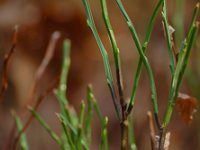Disease of Bilberry (Phytophthora)

Phytophthora ramorum, a notifiable plant disease, has been found on Rhododendron to the north of the Cannock Chase Country Park.
It was originally suspected to be implicated in the dieback of bilberry. It has not been isolated in laboratory tests but we cannot discount it as a threat to bilberry, which has been infected by it on one site in north Staffordshire.
Confirmed Phytophthora infections are generally restricted to the northern part of the Country Park, in and around Brocton Coppice, with several areas recently becoming infected to the south, around the Katyn Memorial.
The threat to Cannock Chase
The Cannock Chase Special Area of Conservation (SAC) is of international importance for its heathland plant communities. Bilberry, cowberry (Vaccinium vitis-idaea) and their nationally rare hybrid (V. x intermedium) are characteristic components of those communities, and the condition of the heathland would suffer substantially if they were lost.
Heather (Calluna vulgaris), the other key heathland component, and sessile oak (Quercus petraea), the dominant species in Brocton Coppice, are both potential hosts of Phytophthora species. There is currently no evidence that they are infected, but if they were to succumb, the prospects for the Cannock Chase heathlands and ancient woodlands would be grim indeed.
Control Strategy
Wild animals, horses, dogs and their owners are all potential carriers of spores.
For this reason we are asking visitors:
- to keep to the main tracks
- not to stray into the vegetation
- to keep dogs on short leads at all times in the main affected areas
The map below shows the areas where these access restrictions apply.
The great majority of visitors are complying with these requests which are indicated on signs at the car parks, but a minority are not.
If the risk of the spread of spores cannot be controlled in this way we may have to request Natural England to impose more stringent access restrictions on the Country Park. In the meantime we will not give consent for any organised 'off-track' activities that would take people or their animals into potentially infected vegetation.
With thanks
We would like to thank all of the walkers, riders, mountain bikers, orienteers, bird watchers, dog owners and casual visitors who have heeded our requests to help control the disease.
Without your co-operation we would be forced to consider more stringent access controls. Let us hope that it does not come to that.
Contact
If you would like any more information please email us at: phytophthora@staffordshire.gov.uk